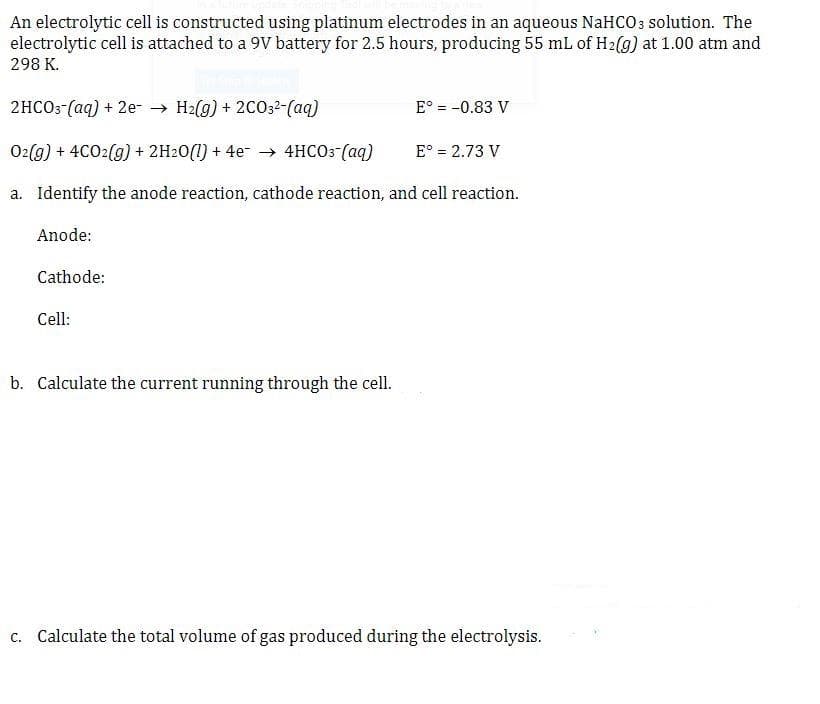An electrolytic cell is constructed using platinum electrodes in an aqueous NaHCO3 solution. The electrolytic cell is attached to a 9V battery for 2.5 hours, producing 55 mL of H₂(g) at 1.00 atm and 298 K. 2HCO3(aq) + 2e → H₂(g) + 2CO3²-(aq) E° = -0.83 V O2(g) + 4CO2(g) + 2H2O(l) + 4e → 4HCO3- (aq) E° = 2.73 V a. Identify the anode reaction, cathode reaction, and cell reaction. Anode: Cathode: Cell: b. Calculate the current running through the cell. c. Calculate the total volume of gas produced during the electrolysis.
An electrolytic cell is constructed using platinum electrodes in an aqueous NaHCO3 solution. The electrolytic cell is attached to a 9V battery for 2.5 hours, producing 55 mL of H₂(g) at 1.00 atm and 298 K. 2HCO3(aq) + 2e → H₂(g) + 2CO3²-(aq) E° = -0.83 V O2(g) + 4CO2(g) + 2H2O(l) + 4e → 4HCO3- (aq) E° = 2.73 V a. Identify the anode reaction, cathode reaction, and cell reaction. Anode: Cathode: Cell: b. Calculate the current running through the cell. c. Calculate the total volume of gas produced during the electrolysis.
Chemistry: The Molecular Science
5th Edition
ISBN:9781285199047
Author:John W. Moore, Conrad L. Stanitski
Publisher:John W. Moore, Conrad L. Stanitski
Chapter19: The Chemistry Of The Main-group Elements
Section: Chapter Questions
Problem 73QRT
Related questions
Question
ANSWER TO C IS NOT 83ml PLEASE ONLY ATTEMPT IF YOU CAN DO THIS WHOLE PROBLEM CORRECTLY

Transcribed Image Text:An electrolytic cell is constructed using platinum electrodes in an aqueous NaHCO3 solution. The
electrolytic cell is attached to a 9V battery for 2.5 hours, producing 55 mL of H₂(g) at 1.00 atm and
298 K.
2HCO3(aq) + 2e- → H₂(g) + 2CO3²-(aq)
E° = -0.83 V
O2(g) + 4CO2(g) + 2H₂O(l) + 4e¯→ 4HCO3- (aq)
E° = 2.73 V
a. Identify the anode reaction, cathode reaction, and cell reaction.
Anode:
Cathode:
Cell:
b. Calculate the current running through the cell.
c. Calculate the total volume of gas produced during the electrolysis.
Expert Solution
This question has been solved!
Explore an expertly crafted, step-by-step solution for a thorough understanding of key concepts.
Step by step
Solved in 2 steps with 2 images

Knowledge Booster
Learn more about
Need a deep-dive on the concept behind this application? Look no further. Learn more about this topic, chemistry and related others by exploring similar questions and additional content below.Recommended textbooks for you

Chemistry: The Molecular Science
Chemistry
ISBN:
9781285199047
Author:
John W. Moore, Conrad L. Stanitski
Publisher:
Cengage Learning

Principles of Modern Chemistry
Chemistry
ISBN:
9781305079113
Author:
David W. Oxtoby, H. Pat Gillis, Laurie J. Butler
Publisher:
Cengage Learning


Chemistry: The Molecular Science
Chemistry
ISBN:
9781285199047
Author:
John W. Moore, Conrad L. Stanitski
Publisher:
Cengage Learning

Principles of Modern Chemistry
Chemistry
ISBN:
9781305079113
Author:
David W. Oxtoby, H. Pat Gillis, Laurie J. Butler
Publisher:
Cengage Learning


Chemistry: Principles and Reactions
Chemistry
ISBN:
9781305079373
Author:
William L. Masterton, Cecile N. Hurley
Publisher:
Cengage Learning

Principles of Instrumental Analysis
Chemistry
ISBN:
9781305577213
Author:
Douglas A. Skoog, F. James Holler, Stanley R. Crouch
Publisher:
Cengage Learning

Chemistry
Chemistry
ISBN:
9781305957404
Author:
Steven S. Zumdahl, Susan A. Zumdahl, Donald J. DeCoste
Publisher:
Cengage Learning